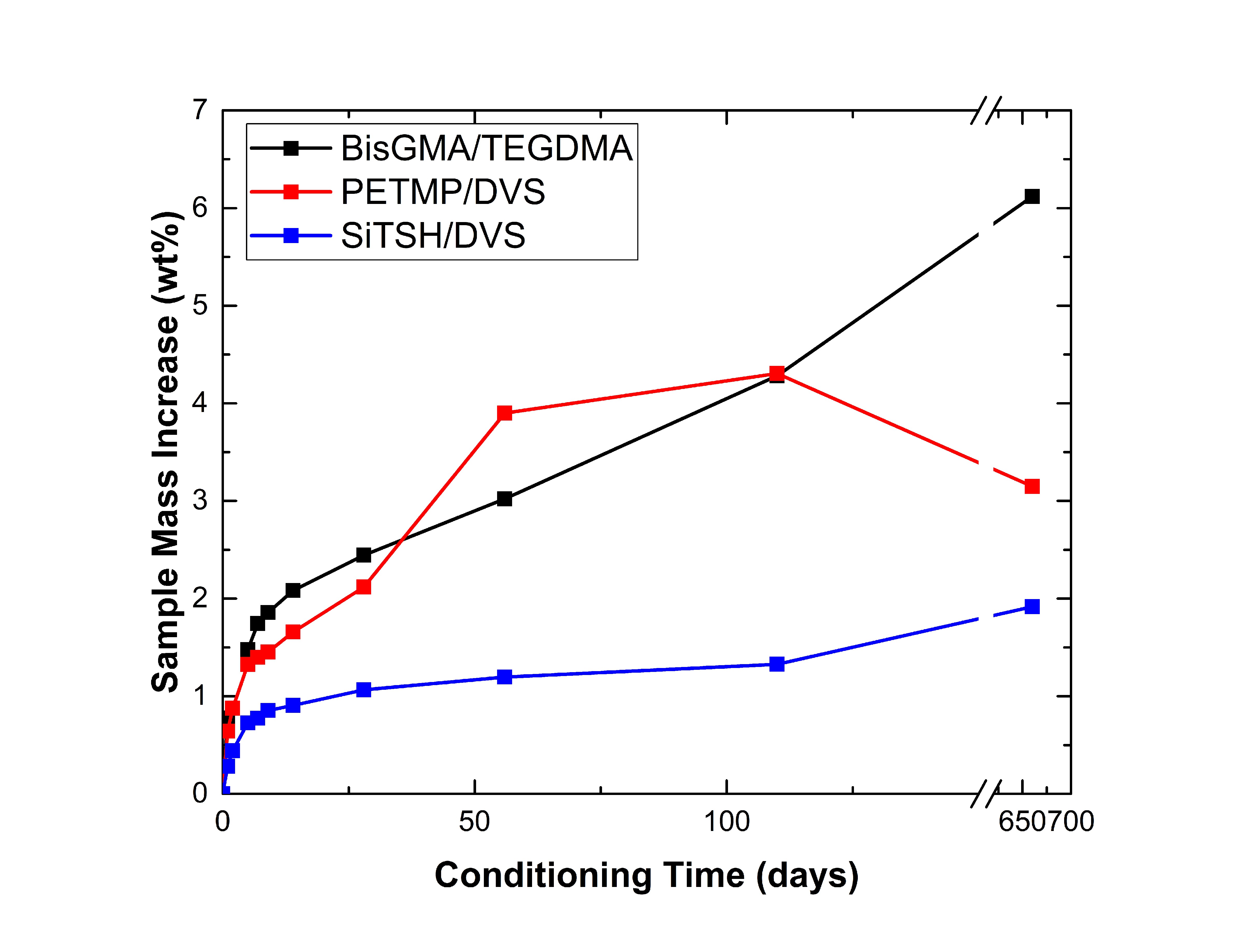IADR Abstract Archives
Hydrolytic Stability of Thiol-Michael Dental Composites
Objectives: Step-growth thiol–Michael photopolymerizable resins were developed and evaluated for use as dental restorative materials. The beneficial features inherent to anion-mediated thiol-Michael polymerizations such as rapid photo-curing, low stress generation, ester content tunability, and improved mechanical performance in a moist environment were explored.
Methods: Four thiol-Michael resins of varied ester content were fabricated under suitable light activation and the properties of the generated resins and silica-filled composites were evaluated and compared with a conventional methacrylate dental system comprised of two standard dental dimethacrylates, BisGMA and TEGDMA. Polymerization kinetics and shrinkage stress were determined with FTIR spectroscopy coupled with tensometery measurements (n=3). Thermo-mechanical properties were evaluated by dynamic mechanical analysis (n=3) and in three-point bending stress-strain experiments (n=6). Furthermore, two thiol-Michael and control composite were cured under 300 mW/cm2 of 320-390 nm light at ambient temperature. The rectangular samples (2×4×25 mm) were placed in distilled water at 37 ○C, and their dry mass was monitored over the course of 2 years. The mechanical performances were compared before and after extensive conditioning in water (n=3).
Results: Low-ester thiol-Michael composite systems show stable mechanical performance after extensive water treatment. The ester free thiol-Michael composite absorbs only 2 wt. % of water, quickly reaching equilibrium, whereas the BisGMA/TEGDMA control composite exhibits a continuous increase. (Fig 1) Moreover, after two years of uninterrupted water exposure, the dimethacrylate control suffered over 40% drop in modulus, over 60 % drop in flexural strength, and close to 80% drop in toughness. On the other hand, the ester free thiol-Michael composite has remained practically unaffected in terms of modulus (4.3±0.2 GPa), strength (45±3 MPa), and toughness (1.0±0.4 J m-3).
Conclusions: Although further resin/curing methodology optimization is required, the photo-polymerized thiol-Michael prototype resins can be recognized as promising candidates for implementation in composite dental restorative materials.
Methods: Four thiol-Michael resins of varied ester content were fabricated under suitable light activation and the properties of the generated resins and silica-filled composites were evaluated and compared with a conventional methacrylate dental system comprised of two standard dental dimethacrylates, BisGMA and TEGDMA. Polymerization kinetics and shrinkage stress were determined with FTIR spectroscopy coupled with tensometery measurements (n=3). Thermo-mechanical properties were evaluated by dynamic mechanical analysis (n=3) and in three-point bending stress-strain experiments (n=6). Furthermore, two thiol-Michael and control composite were cured under 300 mW/cm2 of 320-390 nm light at ambient temperature. The rectangular samples (2×4×25 mm) were placed in distilled water at 37 ○C, and their dry mass was monitored over the course of 2 years. The mechanical performances were compared before and after extensive conditioning in water (n=3).
Results: Low-ester thiol-Michael composite systems show stable mechanical performance after extensive water treatment. The ester free thiol-Michael composite absorbs only 2 wt. % of water, quickly reaching equilibrium, whereas the BisGMA/TEGDMA control composite exhibits a continuous increase. (Fig 1) Moreover, after two years of uninterrupted water exposure, the dimethacrylate control suffered over 40% drop in modulus, over 60 % drop in flexural strength, and close to 80% drop in toughness. On the other hand, the ester free thiol-Michael composite has remained practically unaffected in terms of modulus (4.3±0.2 GPa), strength (45±3 MPa), and toughness (1.0±0.4 J m-3).
Conclusions: Although further resin/curing methodology optimization is required, the photo-polymerized thiol-Michael prototype resins can be recognized as promising candidates for implementation in composite dental restorative materials.

